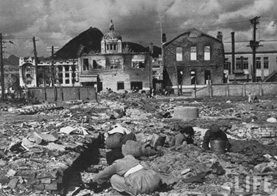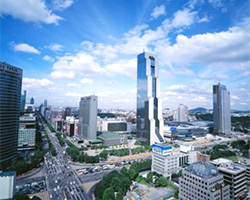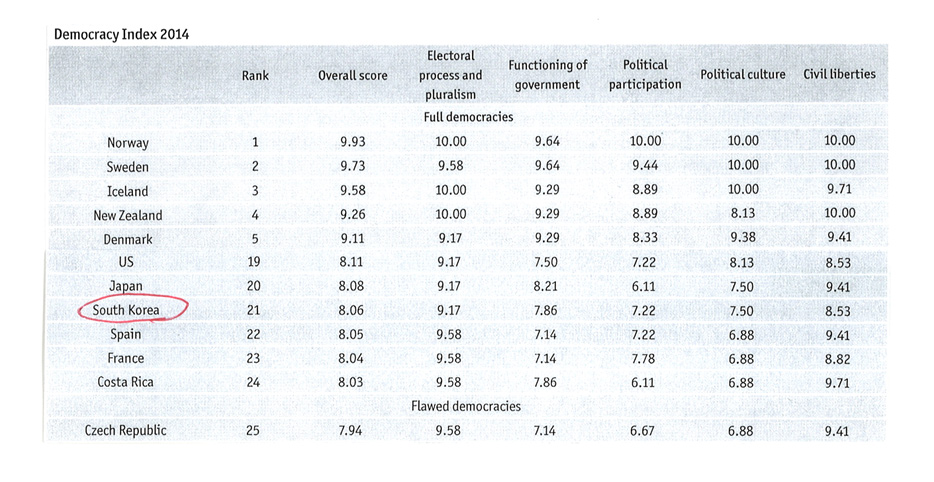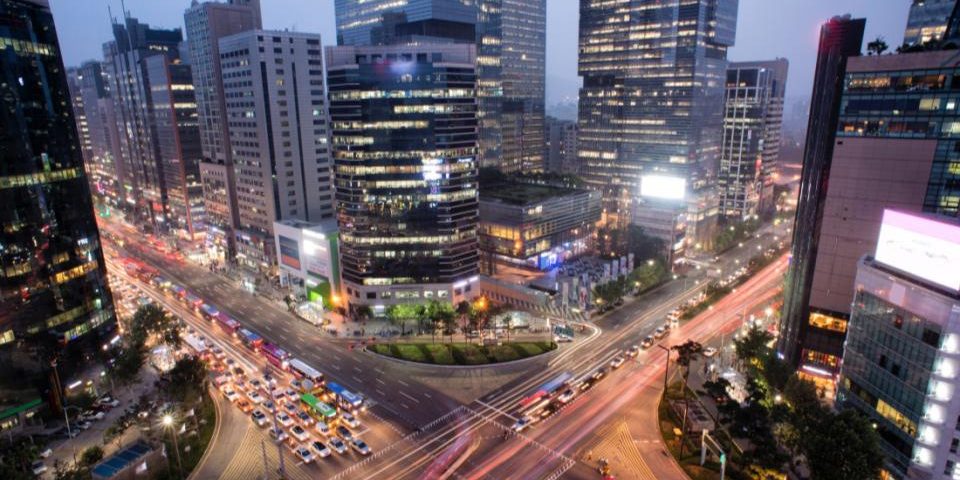South Korea, though it is a latecomer, has made unprecedented achievements in both economic development and democratization. As a result, South Korea, a former developing country, is now one of the most popular role models among developing nations throughout the world. Out of the 80 countries in the world that became independent after WWII, South Korea is the only one that achieved both democracy and economic development to the average level of European Union countries.
Now, let’s take a closer look at what South Korea has achieved for the last 50 years and what the secrets of its success were.

What did South Korea look like in 1950’s?
About 50years ago, in the wake of the Korean War (1950-1953), South Korea was one of the poorest countries in the world with its per capita Gross Domestic Product of a mere $67. Its infrastructure was destroyed by the Korean War and millions lived in extreme poverty, with thousands of unemployed people struggling to fulfill basic needs. North Korea had been better off than South Korea until the mid 1970’s. South Korea once received economic aid from Thailand and the Philippines.
 Economic Success to the Level of European Union (EU) Countries
Economic Success to the Level of European Union (EU) Countries
However, for the last 50 years, South Korea has gone through a miraculous economic development. South Korea today is one of the most prosperous economies with a GDP of $1,376 billion (2015) and the 11th largest economy in the world. Its per capita GDP has increased by more than three hundred times for the past 60 years to around $36,000. The GDP per capita in terms of PPP (Purchasing Power Parity) is equal to the average European Union (EU) countries.
South Korea now possesses more than 140 items of world top selling products. As a case in point, South Korea’s shipbuilding industry is ranked No. 1 in the world, whereas its steel industry is ranked No.6. It also has two consumer electronics firms that are among the top ten electronics manufacturing companies in the world. The mobile phones manufactured by Korean companies accounted for 66% of the global mobile phone market in Q1 2013, and took the share of nearly 44% ofthe US market in 2012. LCD TVs made by Korean firms took up 41% in Q1 2013, and now South Korea is the world’s 5th largest car producer. It is no wonder that Korea joined the “trillion dollar club” in trade volume in 2011, which has a membership of only nine countries in the world.
Above all, in 2010’s South Korea has made two unprecedented World Records.
- South Korea has become a major donor country for the first time in its history as once-aid-recipient country, by joining the OECD (Organization for Economic Cooperation and Development) DAC (Development Assistance Committee) in 2010.
- In 2012, South Korea joined the ‘20-50 Club’ that consists of countries with a per capita GDP of more than $20 thousand and a population of more than 50 million. South Korea became the 7th member of the Club in the world, following the United States, Japan, Germany, France, Italy, and England and the first and only member that was once an aid-recipient country.
The ‘Miracle on the Han River’ is a term used to refer to South Korea‘s postwar export-fueled economic growth, including rapid industrialization, technological achievement, education boom, large rise in living standards, rapid urbanization, impressive skyscraper construction, modernization, successful hosting of the 1988 Summer Olympics and co-hosting of the 2002 FIFA World Cup. This growth was accompanied by a democratization and globalization that transformed the country from the ashes of the Korean War, to a wealthy and developed country with a globally influential economy and prominent multinational conglomerates, such as Samsung, LG, and Hyundai-Kia.
More specifically, this phrase refers to the economic growth of Seoul, through which the Han River flows, though it is generally used in reference to the country. Also, the ‘miracle’ generally refers to the miraculous economic development from 1961 and 1996. The phrase comes from the ‘Miracle on the Rhine,’ used to describe the economic rebirth of West Germany after World War II.
When General Park Chung-hee was elected as president power in 1963, South Korea had a GDP per capita of less than $100 per year. In the 1960’s, South Korea was mostly dependent on foreign aid, largely from the U.S and Japan. The New Community Movement focused on developing rural South Korea. The strong leadership of the government, though sometimes criticized as repressive and heavy-handed, served as catalyst for the South Korean economic growth.
In less than four decades, Seoul was transformed into a global city, a center of business and commerce in Northeast Asia and a highly developed economic hub, laying the grounds for an advanced technological and communications infrastructure. This rapid growth is considered by Koreans as a symbol of national pride and self-sufficiency.
Political Success: to a Country of Democracy
South Korea did not grow only economically. It achieved political development as well. According to the annual democracy index by EIU (Economist Intelligence Unit), South Korea ranked No. 20 to 22 from 2010 to 2015.

Democracy Index 2014 by EIU (www.eiu.com)
South Korea’s democracy was not gained at one time. It once experienced repressive regimes. However, the strong will and determination of the people for a better country,has enabled South Korea to achieve this high standard of democracy. South Korea’s democracy is quite laudable in that it has been achieved in the midst of the very unfavorable security environment with constant threats and provocations from North Korea ever since the Korean War.
Special Meaning of the Successful Development
Why is Korea’s development so remarkable? It is because South Korea has made an achievement not only in economy, but also in democracy from scratch to the level of average EU countries in just 50 years, which is unprecedented in world history. For these reasons, South Korea has now become the most popular model for developing countries and is actively playing its role as a bridge between developed and developing countries.
Secrets of Korea’s Successful Development
Now you may ask how South Korea achieved both economic development and political democratization while most other developing countries did not, especially given that South Korea was completely destroyed after the Korean War. Unlike some other developing countries, South Korea has unfavorable environmentsfor development, such as small territory with scarce natural resources and the constant threat from North Korea even after the War. How did South Korea overcome all these difficulties and become the only country to achieve such a development? What are the secrets?
Education
Most Koreans are future-oriented. They are willing to invest inthe education of their children, believing that good education is the key to both individual success and national development. This strong educational zeal of South Koreans has enabled them to provide better education for their children. South Korea’s enrollment rate in tertiary education recorded 98% in 2012. High quality of manpower with strong motivation hasplayed a crucial role in making South Korea a nation with the top-ranking high-tech industry as it is today. The very high ratio of highly educated citizens contributed to the democratization of South Korea as well. In addition, many South Koreans who studied in the U.S. and European countries disseminated the western values of freedom and democracy in South Korea after they returned home.
Lessons from South Korea’s successful development?
Now we understand that South Korea’s successful development is very unique and unprecedented. Let’s think about what we can learn from this story.
Firstly, we can learn that the fate of a county mainly depends on the attitude of its people. In spite of unfavorable environmental conditions such as small territory, scarce natural resources and constant threats from North Korea, South Korea overcame all these difficulties with a strong will and determination of its people and achieved its goal.
Secondly, we can learn that democracy and a market economy prevail over communism and a controlled economy. South Korea and North Korea had been one country for 1,500 years. Their people are the same. The only differences are their systems. Now North Korea is regarded as one of the most failed countries, while South Korea is regarded as a successful country. A comparison of the two Koreas is the clearest example that a combination of democracy and a market economy is a better system.
Thirdly, the contribution of donor nations in the international community to countries in need is in the contributing nation’s interest in the long run. For example, a small country as the Netherlands made a great contribution to the survival and successful development of South Korea by sending 5,322 Dutch soldiers and 6 naval vessels to defend South Koreafrom the aggression by North Korea in the Korean War from 1950 to 1953, and providing economic aid for South Korea for quite a long time. Thanks to the support of the international community including the Netherlands, South Korea has achieved economic development and political progress and stands on its feet.Now, look at the benefit for the Netherlands from sending troops and using taxpayers’ money for South Korea. The trade between the Netherlands and South Korea and the investment of South Korea to the Netherlands created tens of thousands of jobs in the Netherlands. In addition, democracy and the market economy system that the Netherlands upholds become stronger with the existence of South Korea with their shared interests and values.
What does South Korea make?

Hi-tech companies, in particular, have made the economy of South Korea flourish and prosper. For example, Samsung Electronics is one of the largest electronics companies in the world. It produces high-tech smart phones, tablets, computers, photo cameras, and televisions, to name just a few. Especially, it is the No. 1 company in the global mobile phone market, selling more than 1 million phones a day. It is located in more than 58 countries and has more than 90,000 employees.
Hyundai Motor Company makes cars and trucks. It is also responsible for the production of Kia automobiles. It sells more than 3.5 million cars per year and employs over 60,000 people. This Korean company is now one of the top 5 car producers in the world.
LG Corporation,of the largest multinational conglomerates in South Korea,covers business areas in electronics, chemicals, and telecom service, producing and exporting to over 80 countries, above all,conditioners, high-tech smart televisions with OLED screens,phones and refrigerators.
South Korea boasts of the world’s top ranked shipbuilding industry along with one of the largest ports in the world (Busan). Hyundai Heavy Industries is a global player in the shipbuilding industry.
Do you want to know more of the economy in South Korea?
Please, refer to the video clip titled “The Secrets behind South Korea’s Economic Development” on You Tube.
Statistical information: http://www.cia.gov (World Fact Book), http://worldbank.org (World Bank), http://www.state.gov(U.S. Department of State), and http://www.imf.org(International Monetary Fund)
(The articles were created by Key Cheol Lee when he served as South Korea’s Ambassador to the Netherlands. In 2016, he began his service as the Consulate General of the Republic of Korea in Los Angeles)
